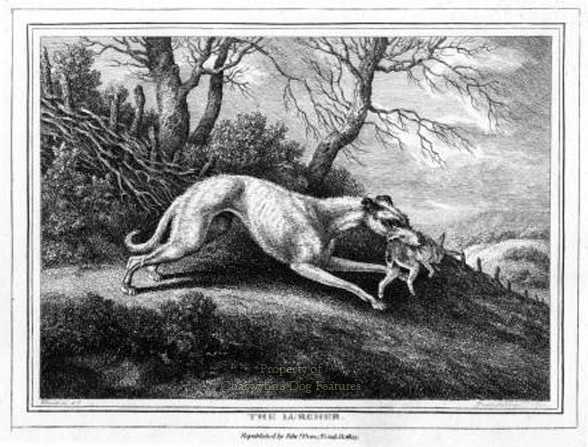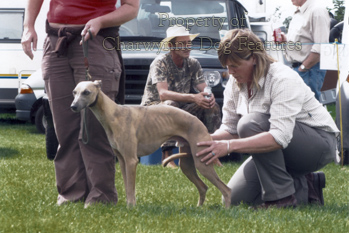436 Looking at Lurchers
LOOKING AT LURCHERS
by David Hancock
 Judging any breed of dog in a ring is always going to be a combination of judgement, ideally objective, knowledge and a technique. Sadly far too many judges that I see appear to base their decisions on 'gut-feeling' or by taking a shine to a particular dog on the day. Watching the 2004 Crufts judging was disappointing for me, a personal view of course. A handsome Whippet won not only the Hound Group but was awarded best in show. For me this exhibit was too short in the body, although long in the back. This is a serious weakness in any sighthound; it restricts lung room, the last rib being too far forward, and places extra stress on the loin. I thought that the Saluki which came second in the Hound Group was a superior dog.
Judging any breed of dog in a ring is always going to be a combination of judgement, ideally objective, knowledge and a technique. Sadly far too many judges that I see appear to base their decisions on 'gut-feeling' or by taking a shine to a particular dog on the day. Watching the 2004 Crufts judging was disappointing for me, a personal view of course. A handsome Whippet won not only the Hound Group but was awarded best in show. For me this exhibit was too short in the body, although long in the back. This is a serious weakness in any sighthound; it restricts lung room, the last rib being too far forward, and places extra stress on the loin. I thought that the Saluki which came second in the Hound Group was a superior dog.
Now that is a purely personal view, from a distance. The Hound Group judge is a vastly experienced scenthound expert and he gave each exhibit a very comprehensive examination, being one of the few on the day to test the loin. He knows far more about scenthounds than I will ever know. The point I am making is that from a distance it is often possible to gain a very different opinion of an exhibit than from a more intimate hands-on examination of one. Ringside judges have no responsibilities and no accountability. This doesn't stop any number of disgruntled spectators, sometimes blind to the faults of the type they favour, voicing dissident views. And why not? Judging dogs on their appearance will always produce varying views.
A judge with knowledge is always going to triumph over one just hoping to get his decisions right. A judge with a technique is more likely than any other one to make sound decisions. Fanciers who pay money to enter a ring and travel a long way to get there deserve a competent judge. But time and time again, especially at lurcher and terrier shows, I watch judges at work in the ring, who apply a different sequence to each exhibit, only check one aspect of movement and fail even to examine some parts of the dogs' anatomy. I don't believe that their judgements are subsequently soundly based. In any field of human activity knowledge applied through a tried and tested technique will surpass 'gut-instinct' every time.
Far too many exhibitors at country shows expect the judge to see merit in their entry when they themselves have done little to prepare the exhibit for the ring. Some dogs are natural showmen, most are not. Dogs need to be schooled for the ring - not slavishly prepared, God forbid! but trained to walk briskly on the lead and stand still during closer scrutiny. A future judge's examination of the bite is made easier by previous rehearsal. Why should your dog unquestioningly allow a complete stranger to look inside its mouth? But jaw construction really does matter and a competent judge will always want to check this important feature of a sporting dog. The judge can better apply his judging technique if the exhibitor's ring technique has been practised and the exhibit rehearsed. This can significantly affect placings.
The most valuable purpose for me in showing dogs in any ring is to identify future breeding material. The most important factor for me is: could this dog carry out its breed function? We all like a handsome dog but handsome unsound dogs, sadly, do win. I attended the 2003 World Dog Show in Dortmund and spent several days at the show. I have never seen so many unsound dogs under one roof in my entire life; some of them won prizes! Sportsmen expect their dogs to function. This capability is so much more important than beauty or breed type, the latter originating in function, but is so regularly betrayed by human whim. Lurchers must never be judged on cosmetic appeal but on their anatomy's ability to carry through their function. Those breeding for flashy markings beware!
Fault judging is no help to anyone, breeder, owner, the status of the show, the sport of showing itself. Overseas they often list faults according to their seriousness, i.e. disqualifying ones down to merely undesirable ones. No lurcher should ever win in the ring if it features upright shoulders, short upper arms, a weak neck or loins, poor feet, a short body (especially with a long back) or shoulder blades which touch when the dog stoops to put its nose to the ground. There is no such thing as the perfect dog; it's vital to judge the whole dog, not descending on the animal, oozing praise just because it's in superlative condition, has powerful hindquarters or a superb head. The sporting dog needs every part of its body to be sound! In KC show rings far too many breeds are judged solely on their heads or their coats or their flashy gait. As ye sow...
Movement demonstrates soundness, or reveals flawed physiques; the initial overall appraisal can reveal symmetry and allow assessment of the whole dog. The closer hands-on examination allows the slope of shoulder, the strength of loin, the muscular development, the skeletal frame and the construction of the jaw to be checked. But the sequence of the examination is crucial. For me, it is logical to view the whole dog standing and moving before a closer look is given. And by moving I mean three dimensional: going away, going across and then heading directly for me. I am seeking effortless locomotion, a balanced harmonious economical gait and no excessive action, either to the side or off the ground. Does the dog look as though it could go on like this for miles?
Any closer examination has, for me, to follow a set sequence: head, jaw, eyes and ears, neck and shoulders together, back and loins together, set of tail and pelvic slope together. Then to the lower case: spread and elbows together, front legs AND feet, thorax and tuck-up, hindlimbs AND feet then coat and character. Judging character isn't straightforward; I go for the look in the eye, the tail action and the confident body language. We all surely want keen willing up-on-their-toes sporting dogs. Without a set sequence I'd be worried I'd miss something. I am always willing to converse with an exhibitor in the ring but am aware of crafty attempts to influence me. I was once told by the owner of a splay-footed, wry-mouthed, surprisingly flabby lurcher that his dog regularly caught hares 'single-handed'. 'But never with his mouth!' was my response!
I am always prepared to discuss my placings with exhibitors at the end of the show; I am always willing to give a view on the 'state of the entry' so that some idea is provided on the overall standard of the dogs shown under me. An average dog winning from a tiny entry should not become overrated. In the end, of course, what the dog can do will always be more important than what it looks like. But sound construction will always allow a sporting dog to excel and that is the task of the lurcher judge: to reward soundness, not showiness. Winning dogs get bred from; who wants a kennel full of useless show-offs!